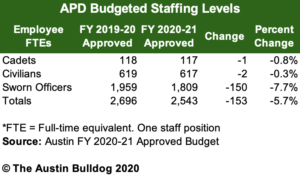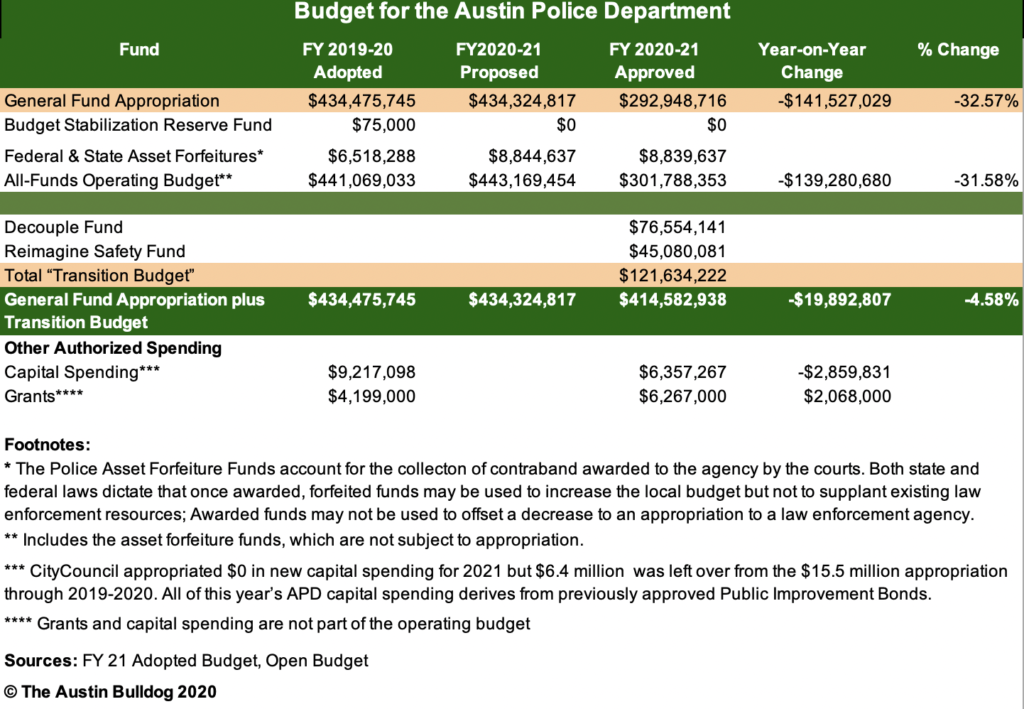Our deep-dive debunks misconceptions and explores what’s next for APD
Did the City of Austin “defund” the police? Did it cut its police budget by 5 percent or by one-third? What’s the truth behind these conflicting claims?
Those are hot-button issues that play into the District 6 and District 10 runoff elections that voters will decide Tuesday, December 15.
The Austin Police Department’s General Fund operating budget this year is $292.9 million, compared to $434.5 million last year, according to the adopted budgets for each fiscal year.
Judging by those numbers alone, police funding in Austin is lower this year by nearly $142 million, or 32.6 percent. But the top-line numbers don’t tell the full story.
As debate swirls around the police budget in ongoing city council runoff races, the Bulldog set out to understand the specifics of the budget numbers.
We recognize that the debate around police funding involves complex and often emotionally charged questions around race, violence, politics, the rule of law, and public safety. Those are matters that can’t be mapped out so easily on a spreadsheet.
But the question of how much money the city council actually cut from the police budget should be easier to pin down. Our analysis is based principally on numbers in the city’s fiscal year 2021 adopted budget, which was published in late November.
Let’s take a look at some of the ins and outs.
‘Immediate Reinvestments’
Prior to the coronavirus outbreak, unemployment in Texas was historically low at 3.5 percent, and Austin’s rate was 2.6 percent. Tight labor market conditions, coupled with repeated delays of cadet classes, led to as many as 180 vacancies at the Austin Police Department (APD), according to a KVUE report of February 21, 2020.
Now, the department won’t get to fill most of those vacancies. The city council voted August 13 to eliminate 150 vacant sworn officer positions. They also decided not to add 30 new officer positions that had been scheduled as part of a long-term staffing plan.
 The council appropriated funds for 1,809 sworn officer positions, compared to 1,959 sworn officer positions approved in last year’s budget—a reduction of 7.7 percent. The number of civilian positions (617) and cadet positions (117) remains largely unchanged from last year.
The council appropriated funds for 1,809 sworn officer positions, compared to 1,959 sworn officer positions approved in last year’s budget—a reduction of 7.7 percent. The number of civilian positions (617) and cadet positions (117) remains largely unchanged from last year.
The council also zeroed out funding for three cadet classes.
Those changes account for the bulk of a roughly $20 million reduction in the APD operating budget compared to last year’s adopted budget—a change of just under 5 percent.
Compared to the “base budget”—a mid-year spending plan that reflects annual salary increases and other cost drivers—the council actually cut $31.5 million. However, for purposes of this article, we’ll stick mostly to a straightforward year-on-year comparison, disregarding intermediate planning documents like the “base budget” or the city manager’s “proposed budget.”
Besides the staffing cuts, the council reduced the overtime budget, delayed the purchase of a records management system and delayed the purchase of new duty weapons.
The new budget reallocated $31.5 million to family violence shelters, homeless services, permanent supportive housing, substance use treatment centers, EMS, and other services. That amount reflects about $11 million reduced from the base budget (what would have been spending increases for APD), and about $20 million in actual year-on-year cost cuts.

Different council members introduced amendments directing how the funds would be spent. For example, Delia Garza secured funding for a mobile food market program for $400,000. Greg Casar secured $1 million to expand harm-reduction services at substance use drop-in centers and mobile outreach clinics.
An amendment proposed by the city staff and adopted by the council reallocated $4 million from APD to the Office of Police Oversight and Equity Office for a variety of audits and oversight tasks, including to conduct “an audit of all disciplinary records held by the Austin Police Department.”
Budget limbo
Beyond the immediate budget cuts, the council envisioned a more ambitious restructuring that would decouple certain units from the police department and potentially eliminate others.
These units were placed in a kind of budgetary limbo referred to as the “transition budget.” Units like Forensics, Internal Affairs, and the 9-1-1 Call Center are still operating under APD but are slated potentially to become independent or be merged with another department.
In all, the council transferred $121.6 million from the police budget into the “transition budget,” which consisted of a “Decouple Fund” of $76.5 million and “Reimagine Public Safety Fund” of $45.1 million, according to the adopted budget.

A budget amendment introduced by Greg Casar, and passed without objection, directs the city manager to “finalize all of the transitions” of units in the Decouple Fund by September 30, 2021. Assistant City Manager Ray Arellano circulated a memo August 10 outlining a quarterly timetable for when certain units could be “easily transferred from APD.” To date, however, the city hasn’t reported completing any transfers of units out of APD.
Of the two funds, the Reimagine Fund comprises police units that are more likely to end up on the chopping block. These programs “could potentially be separated from (APD) or ended,” according to the FY 21 Approved Budget. Casar’s Amendment 3, which created the fund, says that its goal is to “divert dollars from the fund toward alternative forms of public safety and community support, through the year-long reimagining process.”
The units slated for “reimagining” include Mounted Patrol ($2 million), Explorers (a youth program, $0.3 million), Highway Enforcement ($2.8 million), Park Patrol ($5.6 million), Lake Patrol ($1.4 million), and Nuisance Abatement ($0.3 million).
Decouple Fund not very decoupled
The budget amendments that created the Decouple Fund and Reimagine Fund don’t actually preclude the city manager from spending these funds on APD—and in fact they imply that he will do so.
“The funding set aside in the Decouple and Reimagine Safety funds will continue to fund public safety programs while the reimagining process takes place,” Chief Financial Officer Ed Van Eenoo wrote, in the narrative portion of the FY21 Approved Budget.
In fact, according to the city’s Open Budget website, about 9 percent of the “Decouple Fund” is already exhausted, due to nearly $7 million spent so far on existing APD functions like 9-1-1, Internal Affairs, and Evidence Control.
Likewise, the city has already spent more than $4 million out of the $45.1 million Reimagine Safety Fund for APD functions, including for DWI Enforcement, Recruiting, Highway Enforcement, and investigations of major traffic accidents.
In other words, the Decouple Fund isn’t very decoupled from APD itself—at least not yet. And the Reimagine Fund, while it exists on paper as something separate from APD, for now is basically just a conduit of money to APD itself.
Hardest decisions yet to come
This raises a question: What’s the point of these funds? If the council had wanted to move particular units to different departments, or stand them up on their own, then why not just do so by budget amendment later this year?
The answer to that question lies in the council’s internal politics. The transition funds are the outcome of a tenuous political compromise.
Over the summer, the council was broadly in agreement that it wanted to restructure the police department. But members hadn’t come to a consensus about how much to cut, nor exactly which police functions would be eliminated, transferred, or spun off on their own.
A sharp divide within the council broke into public view at meetings in June. In the aftermath of a weekend of turbulent protests at the APD headquarters, the council met June 4 to consider a previously scheduled motion to accept a state grant for auto-theft detectives. Council members Casar, Jimmy Flannigan, Garza, and Natasha Harper-Madison voted against it.

Council Member Pio Renteria, casting a vote for the grant, complained of “constant” auto theft in his district. He added, “If we want to go out here and start doing these crazy things of defunding everything…then y’all can go ahead, do it. I’ll just tell people, ‘Hey, I tried.’”

At a June 11 meeting, Mayor Steve Adler said he might support a cut of “millions” from the police budget, but Council Members Flannigan and Casar advocated for “more than $100 million” in cuts, according to an Austin Chronicle report. The following week, Garza questioned whether the mayor would be able to get six votes to pass a budget, and threatened to vote against the proposed budget if “significant” funds were not moved out of the police budget.
At the same time, the council was moving forward with plans to put Proposition A on the ballot, an historic tax increase intended to fund new commuter rail. The possibility of a drawn-out fight over policing, just months ahead of an election, could have delayed the budget adoption process and imperiled messaging around a major council priority.
Adler, seeking a compromise, went to great lengths to reassure the more radical wing of the council that he was serious about returning to the policing issue after the election. On August 10, he backed a draft budget rider that would have completely zeroed out the police budget for the second half of the fiscal year (April 2021 through September 2021).

The rider, proposed by Harper-Madison, precluded the city manager from spending any money on APD in that period without specific approval of the council. Adler wrote that “this would force the council back to consider public safety spending.” Casar, likewise, said the restriction would “ensure accountability for the city and the council.”
Harper-Madison’s rider was later watered down. But the transition funds have fulfilled a similar political purpose. Their creation didn’t change much immediately for APD, but it did signal the council’s intention to undertake significant structural changes—and potentially deeper funding cuts as well.
Adler thus far has stuck to his promise of planning for a budget process in the spring—by March at the latest. City staff, including a dedicated “Reimagining Public Safety Core Leadership Team” and Task Force, are also working toward that goal.
That means that the hardest decisions about police spending, and the police department structure, haven’t even been made yet.
Closing ranks
In the meantime, the Police Department has adapted to the $20 million spending cut, and the staff shortage that existed before the budget cut, in part by shifting officers internally.
Prior to the budget cut, APD had been using overtime funds to help staff patrol shifts. It lost that option when the overtime budget was reduced. Chief Brian Manley responded by making plans to shift officers from specialist positions into patrol units.
“Patrol is the backbone of our organization,” Manley said in an August 27 video address to his officers.
An internal APD document leaked to KVUE’s Tony Plohetski detailed that 150 officers from specialized units would move into patrol units. Units that would experience reductions include Organized Crime, Highway Enforcement, and Commercial Vehicle Enforcement.
The DWI unit would be cut from 20 officers to 10, with more DWI enforcement taken up by the patrol units. The 31-member Park Patrol unit would be disbanded.
Manley’s video said that the restructuring wouldn’t go into effect January 17, 2021. But that may have referred only to mandatory reassignments. Officer Bino Cadenas, a Public Information Officer whose position was cut, said September 7 that he was “cleaning (his) desk.”
Cadenas called the strategy a “Band-Aid,” saying it was necessary “due to the city’s decision to cancel our cadet classes…normally new cadets would fill the (patrol) vacancies.”
For Manley, the strategy has the advantage of shifting officers out of specialist units that are slated for “reimagining,” and into patrol ranks that are likely to remain under his command. Under the new budget, for example, the $5.6 million parks unit falls under the Reimagine Fund.
It’s not clear whether Manley’s plan is the final word on the matter. Council Member Kathie Tovo told FOX 7 Austin, “The plan that Chief Manley has drafted is just that, it’s a draft proposal.” Tovo questioned why he would propose such changes when “no personnel have been reduced.”
Fight for new cadets
But while no officers have lost their jobs, the APD workforce is declining through attrition. Without cadets to replace officers who resign or retire, the department will necessarily have to make hard choices about where to allocate resources.
Mayor Adler, Council Member Leslie Pool, and several other council members recently called for new cadet classes in the spring.
Adler said at a council work session December 8, “In order to be able to maintain (staffing) levels in the face of normal attrition we are going to need to have some ongoing cadet classes.”
For some critics of the department, of course, downsizing the department is the whole point. More police doesn’t always mean more safety, they contend. Activists like Austin Justice Coalition, which pushed for the August budget cuts, could put up a fight over reinstating cadet classes.
Public support for reinstating cadet classes appears to be strong, based on the District 6 and District 10 runoff campaigns of challengers Mackenzie Kelly and Jennifer Virden, respectively. Both vow to restore the “$150 million” they say was cut from the police budget.
Adler argued at the December 8 meeting, “A real benefit of doing the reimagining of public safety is decreased need for the number of sworn officers, less reliance on our police as mental health first responders; as we house more people that are experiencing homelessness, less reliance on our police officers as our social workers. That said, I still think there is a critical role for police in our community—even reimagined.
“I for one would like to move forward with a greater sense of urgency to do what it takes in order to initiate a cadet class this spring.”
Greg Casar retorted, “I for one want to make sure that that process is deliberate, isn’t rushed, and that we establish a standard of what we think is acceptable.”
Council Member Renteria took the mayor’s side, saying, I just want to let the public know that we haven’t really defunded the police officers. We still have a force that is the highest paid officers in the state of Texas, and we have supported them with all of the benefits and high pay because we have a lot of faith in them.”
“But there is something wrong with the training, and that’s what my whole focus has been, to make sure that they get proper training to focus on working here in Austin.”
Even Jimmy Flannigan, who was a harsh critic of APD and its leadership over the summer, indicated that he would potentially support new cadet classes, pending completion of training revisions. Yet he and Adler were at pains to suggest that they weren’t backtracking. Reinstating cadet classes would be “entirely consistent with what we did back in August,” Adler said. “This is completely consistent with all of the work we’ve done thus far,” Flannigan said.
They reasoned that the delay that they had imposed had achieved what was intended: buying time to implement curriculum reforms.
But in another sense, reinstatement of the cadet classes would explicitly undo a key aspect of the August budget vote. City Manager Spencer Cronk told the council that reinstating cadet classes this year “would involve coming forward with a budget amendment, because all of the money that had been allocated for these training classes was reallocated by the council in August.”
This brings us back to the question we started with: Did the City of Austin “defund” the police? In short, no, it did not “defund” the police, apart from a 5 percent budget cut. Not only that, if the council reverses itself on the cadet classes, the budget cut this year might actually be less than that, because cadet salaries and training amounted to about $7 million of the total $20 million cut.
At this point, the “reimagining” process could still go in a variety of directions. In respect to the cadet classes, the main thing the council is “reimagining” right now is its own August budget vote.
 Trust indicators: Bulldog reporter Daniel Van Oudenaren is a journalist with more than 10 years experience in local, state, and international reporting.
Trust indicators: Bulldog reporter Daniel Van Oudenaren is a journalist with more than 10 years experience in local, state, and international reporting.
Links to related Bulldog election coverage:
D10 runoff: Alter vs Virden, December 10, 2020
D6 runoff: Flannigan vs Kelly, December 8, 2020








